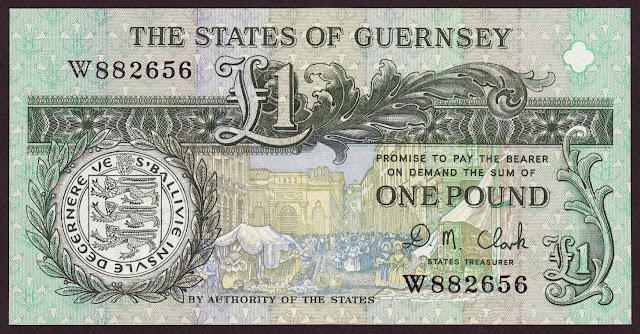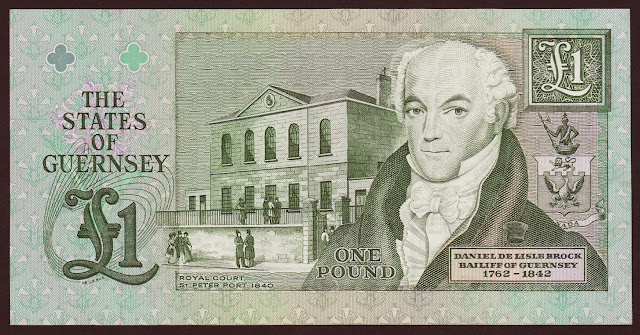Guernsey Banknotes 1 Pound banknote 1991 Daniel de Lisle Brock
The States of Guernsey
Obverse: Seal of The States of Guernsey; The Market (French Halles) now Market Square or Market Place at Saint Peter Port in Guernsey. Signature: D. M. Clark.
Reverse: Portrait of Daniel de Lisle Brock (1762–1842), was Bailiff of Guernsey from 1821 to 1842; Guernsey Lily (Nerine sarniensis); Royal Court building 1840, located in St James Street in St Peter Port.
Watermark: Seal of the States of Guernsey.
Printer: Thomas De La Rue & Company Limited, London England.
Dimensions: 128 x 65 mm
Texts: The States of Guernsey promise to pay the bearer on demand the sum of One Pound, States Treasurer D. M. Clark, by the authority of he States; S'Ballivie Insule Degernereve (The Bailiwick of the Island of Guernsey).
Guernsey banknotes - Guernsey paper money
1980-1991
Daniel de Lisle Brock
Daniel de Lisle Brock (1762–1842), was Bailiff of Guernsey from 1821 to 1842.
Daniel Brock was born 10 December 1762 at St Peter Port on the Channel Island of Guernsey, the third son of John Brock (1729-1777), a midshipman in the Royal Navy, and Elizabeth de Lisle, daughter of Daniel de Lisle, then Lieutenant-Bailiff of Guernsey. The Brocks were an English family who had been established in Guernsey since the sixteenth century. Daniel was a nephew of William Brock (1725-1768), of Brockhurst, St Peter Port (now owned by the National Trust of Guernsey), who was married to Judith de Beauvoir; and Henry Brock, who was married to Susan, sister of Admiral James Saumarez, 1st Baron de Saumarez. Daniel was one of fourteen children, ten of whom attained maturity. He was an elder brother of Major-General Sir Isaac Brock.
After such schooling as the island afforded in those days, he was placed at Alderney to learn French under the tuition of M. Vallat, a Swiss pastor, afterwards rector of St. Peter-in-the-Wood, Guernsey, and subsequently at a school at Richmond, Surrey.
He was, however, taken away at the age of fourteen to accompany his father, who was in failing health, to France, where the latter died at Dinan. He spent about twelve months in visiting the Mediterranean, Switzerland, and France, in 1785-6, and twelve years later, in 1798, was elected a jurat of the royal court of Guernsey, from which time his name is intimately associated with the history of his native place.
On four separate occasions, between 1804 and 1810, he was deputed by the states and royal court of Guernsey to represent them in London, in respect of certain measures affecting the trade and ancient privileges of the island.
In 1821 he was appointed bailiff, or chief magistrate, of the island, and soon after was again despatched to London, to protest, which he did with success, against the extension to Guernsey of the new law prohibiting the import of corn until the price should reach 80s. a quarter.
In 1832, when the right of the inhabitants to be tried in their own courts was menaced by a proposed extension of the power of writs of habeas corpus to the island, Brock and Mr. Charles de Jersey, king's procureur, were sent to London to oppose the measure, and did so with success.
Three years later Brock was once more despatched to London at the head of a deputation to protest against the proposed deprivation of the Channel Islands of their right of exporting corn into England free of duty. Owing to the remonstrance of the deputation, a select committee of the House of Commons was appointed to inquire into the subject, and the bill was subsequently withdrawn. On this occasion the states of Jersey presented Brock with a service of plate, and his portrait was placed in the royal court-house of Guernsey.
Brock was married and had two children: a son, who became a captain in the 20th foot, and a daughter. He died in Guernsey on 24 September 1842. A public funeral was accorded to his remains, in recognition of his long and valued services to his native island.

